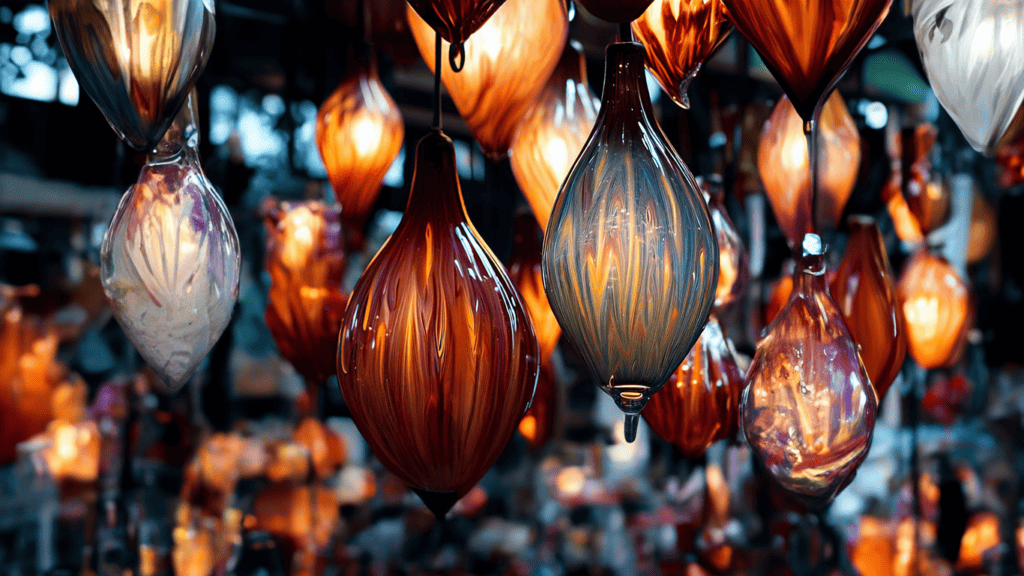Discovering the Elegance of Hand Blown Glass Lamp Parts: Unveiling the Best Sources & Care Tips
Published on 2023年 8月 24日 by iartglass

Introduction
From the glow of a solitary bedside lamp to the majesty of an ornate chandelier, the charm of hand blown glass lamp parts has captivated us for generations. Their ethereal beauty and meticulous craftsmanship set them apart in the vast realm of home decor. As the name suggests, each piece is blown by hand, ensuring a unique touch and distinction to every product. This article offers a deep dive into the world of hand blown glass, its rich history, and the unparalleled craftsmanship behind every creation. Additionally, we’ll guide you through selecting quality pieces and introduce you to the unparalleled range offered by Siga Art Glass.
The Allure of Hand Blown Glass
A Journey Through Time
Hand blown glass, a craft as old as civilization itself, has journeyed through millennia, evolving with every epoch. Here’s a brief chronology of its transformation:

Craftsmanship in Every Curve
The elegance of hand blown glass isn’t just about its translucent beauty. The real magic lies in its creation. Each piece is a result of immense dedication, skill, and years of expertise. Here’s a glimpse into the process:
- Gathering: Artisans begin by gathering molten glass at the end of a blowpipe.
- Shaping and Coloring: While the glass remains hot, it’s shaped using tools and hands. Colors are introduced at this stage, often by rolling the hot glass over small shards of colored glass or by infusing it with metallic oxides.
- Blowing: The artisan then introduces air into the pipe, causing the glass to expand. It’s at this stage the piece begins to take its form.
- Annealing: Once shaped, the glass is slowly cooled in a special oven called a lehr, ensuring its durability and longevity.
Every twist, every curve, and every hue in hand blown glass narrates a story of patience and precision. It’s this intense process that makes pieces like those from Siga Art Glass not just objects of decor, but true works of art.
Siga Art Glass: The Pinnacle of Artistry
In the realm of hand blown glass, certain names stand out, and Siga Art Glass is undeniably among the elite. With its inception rooted in a deep passion for glass art, the brand has carved out an unmatched reputation in the industry.
Unique Offerings
Diving into Siga’s collection is akin to stepping into a world of dreams and artistry. Their offerings range from the understated to the grand. Whether you’re seeking a minimalist glass table lamp base or an intricate dark blue river wave chandelier, their repertoire guarantees satisfaction.
What Sets Siga Apart?
- Craftsmanship: Each piece is a testament to the skills and dedication of Siga’s artisans. From the initial gather of molten glass to the final annealing process, attention to detail is paramount.
- Innovation: Continuously pushing the boundaries, Siga merges traditional techniques with contemporary aesthetics. This is evident in creations like their modern hotel cloud shape design chandelier.
- Authenticity: In an age of mass production, Siga holds tight to authenticity, ensuring every item is genuinely hand blown.
Guide to Choosing Quality Glass Lamp Parts
Choosing the right hand blown glass lamp part is crucial, not just for aesthetics but also for longevity and value. Here’s a comprehensive guide to help you make an informed decision.
Criteria to Consider When Buying Hand Blown Glass
- Transparency & Clarity: High-quality hand blown glass should be clear, with no air bubbles or imperfections.
- Thickness: While the thickness may vary, it should be consistent throughout the piece.
- Finish: Look for a smooth finish without any rough or sharp edges.
- Color Consistency: The color should be uniform unless intentional artistic variations are present.
- Weight: Hand blown glass tends to be heavier than its machine-made counterparts due to its denser composition.
Genuine vs. Mass-Produced: Spotting the Difference
- Handmade Marks: Genuine hand blown glass often has slight asymmetries or unique marks from the artisan’s tools. These are absent in mass-produced items.
- Ponta Mark: A pontil or scar mark on the base is a sign of hand craftsmanship. It’s where the glass was detached from the blowing rod.
- Price: Authentic hand blown pieces, due to the labor and skill involved, tend to be priced higher than mass-produced counterparts.
- Documentation: Renowned brands like Siga Art Glass often provide certificates of authenticity with their pieces, ensuring you’re getting a genuine article.
Being aware of these factors will not only ensure you get the best value for your money but also guarantee you’re investing in a piece that will stand the test of time.
Top Destinations for Hand Blown Glass Purchases
The world of hand blown glass is vast, with artisans and studios spanning the globe. While many destinations offer exquisite pieces, a few stand out for their reputation and quality.
Notable Vendors Across the Globe
- Venetian Artisans: The glassmakers of Venice, especially from the island of Murano, are renowned for their intricate and colorful designs. From chandeliers to vases, their work is globally sought after.
- Scandinavian Studios: Known for their minimalist designs and impeccable craftsmanship, studios in countries like Sweden and Denmark offer pieces that perfectly merge form and function.
- Middle Eastern Craftsmen: With a history dating back thousands of years, regions like Egypt and Syria offer glassworks with intricate patterns and deep, vivid colors.
Of course, in the midst of these global giants, Siga Art Glass has established its foothold, offering a collection that’s both diverse and mesmerizing. Their pieces, ranging from glass bubble lampshades to abstract designs like the hand blown abstract gourd, capture the essence of hand blown artistry, making them a must-visit destination for enthusiasts and collectors.
Diving Deep: The Process Behind Hand Blown Glass Creation
The creation of hand blown glass is a
dance between fire, air, and human touch. It’s an alchemy that turns raw materials into objects of ethereal beauty. But what goes behind this transformation?
From Raw Materials to Art
The journey begins with silica sand, the primary ingredient. This sand, when heated to high temperatures, becomes molten glass. To this molten base, various additives are introduced:
- Soda Lime: Reduces the melting point.
- Limestone: Adds durability.
- Metal Oxides: Introduce vibrant colors.
Once these ingredients meld together in a furnace, the process of shaping begins.
Tools and Techniques of the Craft
Creating a hand blown piece requires a series of specialized tools and techniques:
- Blowpipe: A long metal rod used to gather, blow, and shape the glass.
- Marver: A flat, usually metal surface on which the glass is rolled to shape and cool.
- Jacks: Tools resembling large tweezers, used to shape and cut the glass.
- Punty: A solid rod to which the piece is transferred from the blowpipe, allowing the artisan to shape the other end.
- Glory Hole: A reheating furnace used throughout the process to keep the glass workable.
While these tools assist in the process, it’s the expertise of the artisan, techniques handed down through generations, and innovation that leads to masterpieces. Works from Siga Art Glass exemplify this mastery, combining age-old techniques with modern aesthetics.
Preserving Your Glass Art: Expert Tips
Owning a piece of hand blown glass art is a delight, but like all delicate beauties, it requires care. To ensure your glass artwork remains as resplendent as the day you acquired it, follow these expert guidelines:
Caring for Your Hand Blown Glass
- Gentle Cleaning: Use a soft, lint-free cloth dampened with water or a glass cleaner. Avoid abrasive materials that might scratch the surface.
- Safe Display: Ensure that your glass pieces are displayed in locations where they are less likely to be knocked over. Avoid direct sunlight which might fade the colors over time.
- Dust Regularly: Dust can dull the shine of glass. A soft brush or cloth is ideal for removing surface dust.
Overcoming Common Challenges
- Accidental Chipping: In case of minor chipping, seek a professional to smoothen the edge. Do not attempt DIY fixes.
- Fingerprints and Smudges: Wearing cotton gloves when handling your art piece can prevent smudges and prints.
- Stains: For stubborn stains or residues, a mixture of white vinegar and water can be effective. However, always test on a small area first.
For more tips on maintaining your exquisite pieces, check out The Art of Preservation: Expert Tips for Maintaining the Beauty of Hand Blown Glass.
Products to Look Out For
Siga Art Glass doesn’t just provide products; they offer pieces that tell stories. A few that truly stand out include:
- Crystal Glass Pendant Globe Light: With its crystalline clarity and simplistic elegance, this piece fits seamlessly into any decor theme.
- Murano Hand Blown Double Bubble Glass Ball: Drawing inspiration from Italian craftsmanship, this piece juxtaposes two bubbles, creating a mesmerizing visual play.
- Hand Blown Glass Abstract Fish: More than a lighting solution, it’s a testament to the versatility of glass art, where form meets function in aquatic elegance.
These are just a glimpse of the masterpieces that await your discovery.
Conclusion
The journey of hand blown glass, from its ancient roots to its contemporary manifestations, is a testament to human creativity and perseverance. As we’ve unraveled its history, craftsmanship, and the leading luminaries in the field, the name Siga Art Glass recurrently emerges, embodying the pinnacle of this art form.
So, whether you’re an aficionado, a novice, or simply someone captivated by the allure of glass, a world of ethereal beauty awaits you. Dive deep, explore, and let every piece from Siga Art Glass illuminate your world.




